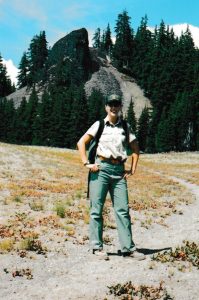
By Les Joslin
On May 10, 2000, about the time I began my eleventh Three Sisters Wilderness season—my first in that temporary seasonal GS-5 forestry technician position to serve as a wilderness ranger-wilderness educator—I accepted a quarter-time Oregon State University position in the Department of Distance & Continuing Education as OSU Statewide Central Oregon Area Advisor in Bend for the period July 1, 2000, to June 30, 2001. Through creative scheduling I was able to discharge those OSU advisor duties and my Forest Service duties in the Three Sisters Wilderness as well as teach the summer iteration of my Central Oregon field geography course. Yep, I was one busy guy! And about to get busier!
I’d never thought seriously about being a university instructor. I lacked that Ph.D. that seemed the necessary prerequisite. Then, in the autumn of 2000, Assistant Professor Bob Ehrhart, assigned to Bend to coordinate and teach in the distance education version of OSU’s bachelor of science degree program in natural resources, asked me if I’d be interested in developing and teaching “an upper division course on amenity uses of natural resources” he’d more specifically define later. A hardworking guy, Bob’s idea of time off that summer had been auditing my Geography 198: Field Geography of Central Oregon course. That’s the only time I recall a Ph.D. enrolled in that freshman-level course.
Apparently he’d liked what he saw. By summer 2001, when Bob got down to brass tacks about the “amenity uses of natural resources” course I would teach for OSU, the topic had morphed into a distance education version of the College of Forestry’s three-credit wilderness management course. I had fall quarter of 2001 to develop the course and winter quarter of 2002 to produce it for online presentation that spring quarter. Production included writing and recording 28 video modules at the Corvallis campus studio as well as developing course materials.
The course, Forestry 352: Wilderness Management, addressed the evolution and application of wilderness as a land use concept from historical, philosophical, political, preservation, planning, and management perspectives. I designed it to provide the potential wilderness manager—or potential natural resource manager who would work with wilderness managers—a comprehensive introduction to the theories and techniques of managing wilderness lands set aside by Congress under the Wilderness Act of 1964 as units of the National Wilderness Preservation System that act established. Wilderness management, I emphasized, is as much social science as natural science. It focuses on minimizing visitor impacts to the wilderness resource and experience through a combination of educational and engineering means and, only when absolutely necessary, through enforcement.
I presented the ten-week course through those 28 video modules—initially on VHS cassettes, later on DVD, and finally via online video streaming—supported by reading assignments in three textbooks. One of these was Roderick Nash’s Wilderness and the American Mind about America’s changing attitude toward wilderness that led to its preservation. A second was John C. Hendee’s and Chad P. Dawson’s Wilderness Management, the definitive textbook and reference. The third was my The Wilderness Concept and the Three Sisters Wilderness which interpreted that National Wilderness Preservation System unit as sort of a “lab rat” for the course.
My approach to teaching this course made it a labor-intensive and time-consuming enterprise. Students wrote six papers—three journal article reviews, two graded review exercises, and a management problem analysis—before taking a comprehensive final exam. This was an upper division university course, and in my mind that meant writing clear, complete, concise responses to questions which required analytical thought and appropriate exposition. Given the state of writing instruction in some high schools and colleges along with some professors’ preference for time-saving objective measurements, some students were not ready for this challenge and taken aback by this approach. “Les, you’re so ‘old school!’” one faculty colleague chided me. “Yes, and proud of it!” I replied.
As an adjunct instructor, not a full-time faculty member, I was able to focus on teaching free of other academic duties such as serving on committees and was not subject to the publish-or-perish syndrome. I did, however, publish three relevant articles in the International Journal of Wilderness.
During the ten years in which I taught the course a dozen times—twice in person in Bend and ten times online—I had some outstanding students, many good ones, and some who should not have been in college. Among the more memorable who performed brilliantly were a medical doctor—an internal medicine specialist in Alameda, California, who told me she was interested in wilderness management as a prospective career—and a national park ranger at Glacier National Park from whose different perspectives I learned.
Several students who completed Forestry 352 signed up for and completed an additional three-credit upper division wilderness field service course during which they worked alongside mounted ranger and packer Jim Leep and me within the Three Sisters Wilderness as well as independently at the Green Lakes Trailhead Information Station to experience a wider spectrum of wilderness management tasks.
I am very pleased to have had this positive university teaching experience.
Les- Thanks for sharing your passion for Wilderness and interesting career. My connection to Wilderness goes back to 1956, before there was any such designation. My family backpacked into Oregon’s Jefferson Park when I was five years old. It was called a primitive area back then. While I am an unabashed proponent of Wilderness, I have a whole lot of angst over which concerns people obsess over and manage for. For me ecology comes first, and management that excludes fire is really bad ecology. To be accurate, a little bit of fire has been let back in Wilderness, but it does not make up for decades of knee-jerk suppression. I see Wilderness managers obsessing over campfire-pits, switchback-cutting, firewood cutting, trash, filming, and the latest- permanent rock-climbing anchors. All of those concerns are annoying to us, yet hardly matter one-wit ecologically. Meanwhile, the giant in the room- decades of fire suppression which has changed vegetation and opportunity for wildlife, goes un-seen.